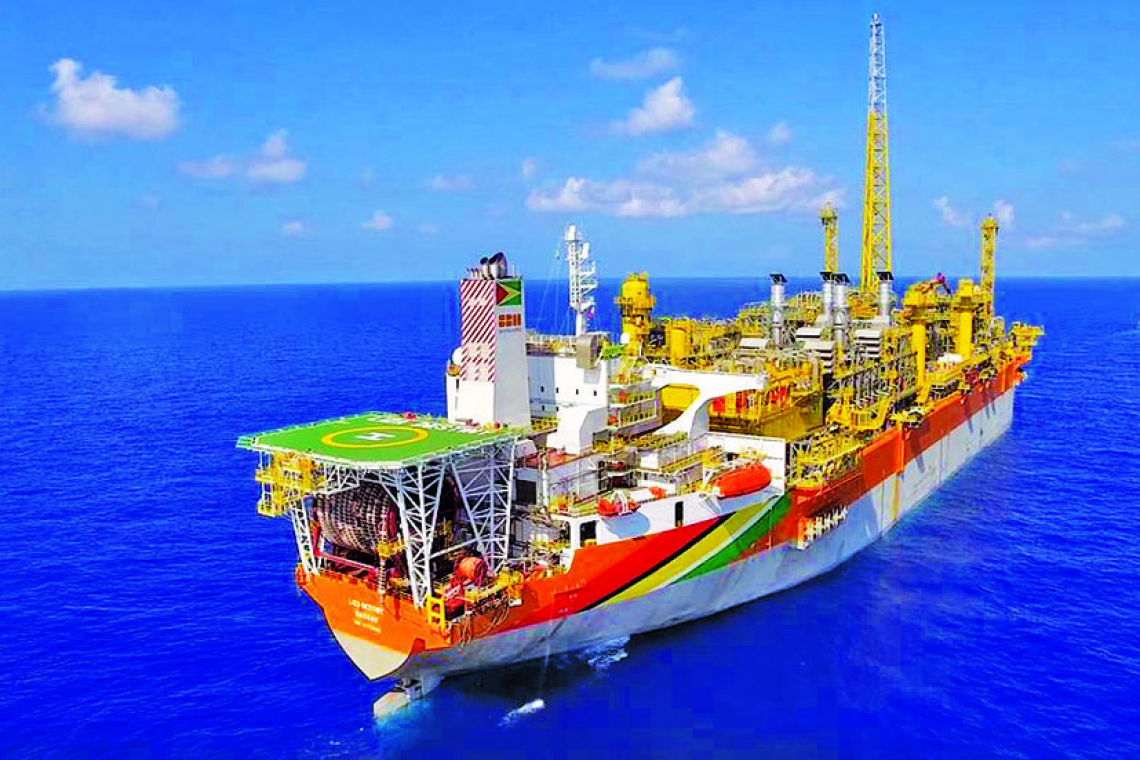The “Liza Destiny FPSO” vessel in the Stabroek Block.
GEORGETOWN, Guyana--After a year that saw delays in ExxonMobil reaching its oil production target, and in commissioning a gas injection system that would cut out flaring, the company has rung in its one-year anniversary of first oil by overcoming both of these obstacles.
According to the company in a statement on Sunday, the Liza Destiny Floating Production Storage and Offloading (FPSO) vessel reached its target of 120,000 barrels of oil per day BPD earlier this month.
For some time, Exxon has cut back on oil production in an effort to reduce flaring of gas due to the fuel injection system not being commissioned. The shortfall of approximately 15,000 BPD in oil production had been a major impediment to Guyana getting its fourth lift, which was originally scheduled for November and has since been rescheduled for this month.
Now that the gas injection system has been commissioned and 120,000 BPD reached, the United States (US) oil giant’s Country Manager Alastair Routledge lauded the work done by the company in overcoming the obstacles.
“We are incredibly proud of the tremendous work of our team in overcoming the challenges of the past year and safely bringing us to where we are today. This resilient group, which includes a growing number of Guyanese professionals, continue to persevere through the COVID-19 pandemic and initial start-up challenges to deliver a world-class project,” Routledge was quoted saying.
During their time in Guyana between 2015 and 2020, it was pointed out that Exxon has spent over $69 billion Guyanese dollars with more than 700 local companies. The company also has more than 2,100 Guyanese supporting its activities on and offshore. The company also noted that investments will continue to increase as Liza Phase Two and its Payara projects advance.
Liza Phase One, which is where Exxon has produced all its oil so far, was the first oil field to be approved for the company. Liza Phase Two was approved last year and is expected to start production in 2022. Payara was approved this year, after an extensive review of the Field Development Plan (FDP), and is likely to start production one year after Liza Phase Two.
According to Exxon, more than 6,000 personnel have been transferred offshore without any safety scares or coronavirus COVID-19 positive cases on the offshore facilities. Routledge expressed disappointment at the equipment issues they experienced this year, but assured that routine flaring will not be used.
“ExxonMobil Guyana is committed to the responsible development of the country’s natural resources and will not utilise routine flaring during our operations,” Routledge explained in the statement.
“We are disappointed by the number of equipment issues experienced and that, because of these issues and COVID-19, commissioning of the gas injection system took longer than originally projected. We took significant steps to limit flaring and are incorporating lessons learned for future projects.”
Guyana, with oil giant ExxonMobil as operator, only began producing oil on December 20, 2019, in the Stabroek Block, lifting its first million barrels of profit oil from the Liza-1 well in February 2020. Oil tanker Cap Phillippe transported this lift from the Liza Destiny Floating Production Storage and Offloading (FPSO) vessel, allowing Guyana to receive its first payment the next month.
That money, $11.4 billion Guyana dollars, constituted Guyana’s first oil revenue-based earnings from production in the Liza-1 field. It was deposited in the Federal Reserve Bank of New York in March of this year.
An additional sum of $7.3 billion Guyana dollars was subsequently deposited, as well as royalty payments. So far, Guyana has received three cargo lift payments and three royalty payments, courtesy of the Liza-1 well. This means more than US $140 million has been deposited in the Natural Resources Fund.
However, this money has remained untouched, as the protracted political crisis that followed the March 2 General and Regional elections sabotaged any attempt to set up a system for withdrawing funds. The Natural Resource Fund Act stipulates that various committees must be established to provide oversight for the fund. It is expected that this legislation will be reviewed by the current government. ~ Guyana Times ~







